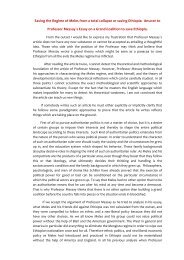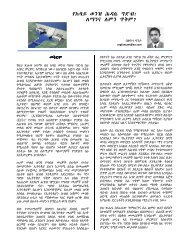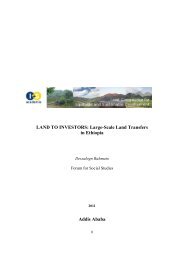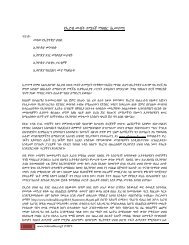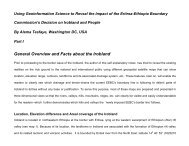Soft States
Soft States
Soft States
You also want an ePaper? Increase the reach of your titles
YUMPU automatically turns print PDFs into web optimized ePapers that Google loves.
Introduction<br />
<strong>Soft</strong> <strong>States</strong>, Strong <strong>States</strong> and Development in Africa<br />
EYASU SOLOMON H.<br />
Can be reached at EYASOL1983@AOL.COM<br />
At the outset it is perhaps important to note that over the past twenty years or so African economic<br />
problems have largely been debated in the context of a narrow of managing economies in crisis<br />
rather than in the broader context of “development”. The reasons for this are commonly known and<br />
do not deserve elaboration. However, at the theoretical level the reasons could be understood to<br />
have had something to do with the decline of “development economics” as the sub-discipline of<br />
economics which has born in the forties and fifties to address issues relating to the economic<br />
problems of the then emerging “development economies”. According to Hirschman (1992) the<br />
ideas put forward at that time shared two basic characteristics: (a) they rejected the monoeconomics<br />
claim of the universality of neo-classical economic analysis and hence its direct applicability to<br />
developing countries (due to a number of well known economic features peculiar to these<br />
countries), and (b) they accepted the mutual benefit claim which asserts that the economic relations<br />
between the advanced countries (the colonizers) and the developing countries (the ex-colonies)<br />
could be shaped in such a way as to yield gains for both.<br />
On the basis of the actual development performance of developing countries over the period<br />
1950-1970, which showed, among other things, that the path to development is neither linear nor<br />
smooth, development economics was subjected to two kinds of attack: “The Neo-classical Right<br />
faulted it for having forsaken the true principles of monoeconomics and for having compounded,<br />
through its newfangled policy recommendations, the problem it set out to solve. For the neo-<br />
Marxist, on the other hand, development economics had not gone far enough in its analysis of the<br />
predicament of the poor countries: so serious was their problem pronounced to be that nothing but<br />
total change in their socio-economic structure and their relation to the rich countries could make a<br />
difference; pending such change, so called development policies only created new forms of<br />
exploitation and dependency” (Hirschman, (1982)). This simultaneous attack on development<br />
economics resulted in its decline. The series of political disasters that struck a number of<br />
developing countries since the sixties, ranging from civil wars to the establishment of murderous<br />
authorization regimes, made it difficult for the discipline to recover.<br />
Judging “development economics” by its policy content, however, Sen (1982) noted that the<br />
strategic themes with which it was concerned addressed common problems that still survive despite<br />
the disappointments of the development experience. These strategic themes include late<br />
industrialization, rapid capital accumulation, mobilization of underemployed rural labor and<br />
“planning and economically active state”. A careful analysis of the development record of the<br />
developing countries in terms of the above policy areas over the period 1960-1980 would show that<br />
“both in terms of cases of success and those of failure the traditional wisdom of development<br />
economics is scarcely contradicted”.<br />
The above conclusion by Sen regarding the policy content of traditional “development<br />
economics” inclusive of the central role of the “state” in the process of development are<br />
increasingly being supported by recent evidence on the evaluation of the development experience in<br />
the various parts of the world. Thus, for example, a careful reading of the World Bank’s (1993)<br />
East Asian Miracle Report shows that indeed the East Asian state was central to bringing abou the<br />
miraculous performance of these countries. Moreover, after nearly two decades of advocating a<br />
minimalist role for the state in “economic management”, the World bank in its 1997 report argues<br />
for an impossibility theorem regarding the role of the state in economic and social development. In<br />
the words of its President the World Bank notes that without “an effective state, sustainable<br />
development, both economic and social, is impossible” (World Bank, 1997: iii).<br />
The major limitation of traditional development economics was its “insufficient recognition that<br />
economic growth was no more than a means to some other objectives”. Thus, for example, in terms<br />
PDF created with pdfFactory trial version www.pdffactory.com
of capability approach to development as articulated by Sen and operationalised by the UNDP<br />
Human Development Reports, if “the government of a poor developing country is keen to raise the<br />
level of health and the expectation of life, then it would be pretty daft to try to achieve this through<br />
raising its income per head, rather than going directly for these objectives through public policy and<br />
social change”. This is the crux of the role of the state in the development process. The question<br />
remains, however, what type of state? And the literature is full of various types1.<br />
The objective of this portion is to provoke further discussion on the “state” in the context of<br />
“development” in Africa. The rest of the portion is organized as follows. In section two, we present<br />
the original logic behind the coinage of the term “soft state”. We note in passing that the “strong<br />
state” can be defined by default as the opposite of the “soft state”. The original formulation of the<br />
term was undertaken in the context of development. Since then a search for a “developmental state”<br />
was mounted. Once again in the context of “developmental achievements” a recent model for such<br />
a “developmental state” was proposed. We review the elements of this model in section three. By<br />
definition a “developmental state” is taken to be a “strong state”, and given the developmental<br />
performance of the recent past the model is base on Asian experience. In section four we test this<br />
model with respect to Africa. In section five we present the most recent World bank position of the<br />
role of the “state” in development and its model for the “right kind of state”. Section six concludes.<br />
The <strong>Soft</strong> State<br />
Myrdal (1968) first coined the term “soft state” in the context of development in his monumental<br />
work on post-independence South Asia. In that context Myrdal characterized Asian states as “soft”<br />
with reference to the general societal “indiscipline” compare to the emergence of the modern state<br />
in Europe. According to Myrdal (1968: 896) “soft states” is a characterization of social reality<br />
meaning that “national governments require extraordinarily little of their citizens. There are few<br />
obligations either to do things in the interest of the community or to avoid actions opposed to that<br />
interest. Even those obligations that do exist are enforced inadequately if at all. This low level of<br />
social discipline is one of the most fundamental differences between South Asian countries today<br />
and Western countries at the beginning of their industrialization”.<br />
A correct reading of Myrdal would show that the social reality of the “soft state” at that particular<br />
point in time was a result of a historical process. To appreciate this we note the following sequence<br />
in the logic of the coinage of the term (Myrdal, 1986:895-900):<br />
(i) In an original setting of village life there existed no difference between social life in preindustrial<br />
European villages and those of developing countries where societies had<br />
“widely ramifying and stratified systems of obligations defining the duties of different<br />
categories of village inhabitants” regarding the construction and maintenance of<br />
infrastructure, the maintenance of local security and defence against aggressors. The use<br />
of land and employment of labor are similarly regulated by custom. These social<br />
relationships were defined in terms of relations between individuals and families “rather<br />
than in terms of a common community interests”;<br />
(ii) The long-term trends of European social relations have been such that they gravitated<br />
toward “the perfection of these systems of obligations and their transformation from a<br />
network of individual relationships into obligations to the community”. Similar long<br />
term trends that could have been observed about village communities in less developed<br />
countries were essentially pre-empted by colonialism which “led to the decay of the<br />
ancient village organization without the creation of a substitute”;<br />
(iii) The less developed countries emerged as a result of a long struggle against a colonial<br />
state and the “liberation movements were rebellions against authority, and the<br />
disobedience to authority was their weapon”. Thus, “disobedience” and “non-co-<br />
PDF created with pdfFactory trial version www.pdffactory.com
operation” were natural forms of protest and defence “against the enforced colonial<br />
power structure”;<br />
(iv) The legacy of the liberation struggle “is a set of anarchic attitudes with an ideological<br />
and emotional force deriving from memories of resistance against the colonial power. In<br />
the newly independent countries, this attitude is now being turned against their own<br />
authorities”.<br />
The above, then, is the logic behind the origin of the term “soft state”. The logic is based on a<br />
reading of the immediate post-independence South Asian experience, but could certainly read as<br />
referring to that of Africa. Central to the analysis, however, is the observation tha the “historical<br />
trends” of natural emergence of a “strong state” in developing countries, where obligations towards<br />
the community are codified as a natural time trend from village based cooperative attitudes, were<br />
derailed by the “colonial encounter”. Like other counterfactuals it will be extremely difficult to<br />
conjuncture whether the term “soft state” would have ever been coined had there been so such<br />
encounter2.<br />
Another important dimension of the above type of analysis informing the coinage of the term, and<br />
indeed its substantive descriptive content, is the possibility of an appreciation of the nature of the<br />
origin of the causal factors behind the dismal development performance of Africa in the recent past.<br />
As noted by a number of contributions to the vast literature on adjustment in Africa, most of<br />
African authors argue in terms of external causation of the continent’s malaise. In contrast, most<br />
non-African authors argue in terms of policy mistakes committed by African “soft states”3.<br />
Developmental <strong>States</strong><br />
Times, of course, have changed since Myrdal wrote his perceptive piece on the political factors in<br />
the process of development policy making. The “soft states” of that time have become the<br />
“developmental states” of recent times. In a contribution Leftwich (1995) proposed what he termed<br />
a “model” for the “developmental state” drawing largely from very recent Asian development<br />
experience. The set of developing countries used by Leftwich is defined by achieving a per capita<br />
growth rate in excess of 4% per annum over the period 1965-1990 and includes South Korea<br />
(7.1%), Taiwan (7%), Singapore (6.5%), China (5.8%), Indonesia ((4.5%), Thailand (4.4%) and<br />
Malaysia (4.4%), in addition to Botswana (8.4%). The objective of the contribution by Leftwich, as<br />
declared in the title of the paper, is to bring “politics back” into development discourse in the sense<br />
that “the single most important factor in generating sustained developmental momentum has been<br />
the presence in each of a particular type of state, a ‘developmental state’, which must be understood<br />
politically” (Leftwich, 1995: 401).<br />
According to Leftwich (1995:401) a developmental state is defined as a state “whose politics<br />
have concentrated sufficient power, autonomy and capacity at the center to shape, pursue and<br />
encourage the achievement of explicit developmental; objectives, whether by establishing and<br />
promoting the conditions and direction of economic growth, or by organizing it directly, or a<br />
varying combination f both”. On the basis of such a definition, and on the basis of the recent<br />
development experience of East Asian countries, Leftwich offered six major descriptive<br />
components to define a developmental state. These can be summarized in the following.<br />
• The character of the developmental elite: there exists a core of developmentally-determined<br />
senior politicians and bureaucrats “close to the executive head of government who was instrumental<br />
in establishing the developmental regime and its culture”. The core elites are characterized by their<br />
intimacy and linkage with their bureaucratic and political components and by being relatively noncorrupt.<br />
• The relative autonomy of the state: which is defined as the ability of the state “to achieve relative<br />
independence from the demanding clamor of special interests” and its ability to override these<br />
PDF created with pdfFactory trial version www.pdffactory.com
interests when it is necessary to do so. Autonomy in this sense does not mean isolation, but rather<br />
“embedded autonomy” in the sense of Evans (1989) where the state forges dense ties with various<br />
actors with the objective of facilitating its economic co-ordination function and its ability of<br />
implementation of developmental objectives. The autonomy of the state is found to be a positive<br />
function of regional competition and external threat, the seizure of power by a modernizing<br />
developmental elite, the dominance of a single party and the inflow of substantial amounts of<br />
foreign aid, loans and private investment.<br />
• The economic bureaucracy: means the specific institutions charged with the responsibility of<br />
managing the interaction between the state and the economy. In shaping development policy, this<br />
economic bureaucracy is found to have real power and authority, to be technically competent and<br />
insulated<br />
• The civil society: by civil society is meant the “web of all privately-organized interests and<br />
groups, above the family level but below that of the state”. Developmental states are said to have<br />
emerged in social contexts where civil society has been crushed or was weak to start with. Starting<br />
from an initial condition, civil societies have been controlled by t he use of internal security<br />
legislation and agencies, secret police and party organizations.<br />
• The non-state economic interests: developmental states are found to have consolidated their<br />
power and autonomy prior to the emergence of influential national or foreign capital and other<br />
economic interests. Subsequently, the state played a major role in encouraging the emergence and<br />
growth of private economic institutions and in shaping their scope and focus of activity in the light<br />
of the articulated development goals.<br />
• The performance criteria: developmental states are found to have been characterized by “brutal<br />
suppression of civil rights”, wide measure of legitimacy and sustained record of delivering<br />
developmental goods.<br />
On the basis of the above characterization of a developmental state Leftwich (1995: 421)<br />
concludes that few “societies in the modern world will make speedy transitions from poverty<br />
without states which approximate this model of a developmental state (ideally, but not necessarily,<br />
the democratic kind)…Contrary to the current orthodoxy, development requires not less state but<br />
better state action, and this is more likely from developmental states. Thus calls for governance, or<br />
democratic governance, which focus on administrative, judicial or electoral good practice, entirely<br />
miss the point that such virtues can only be instituted and sustained by politics”.<br />
While one may agree with the general conclusion of Leftwich that effecting development requires<br />
more, rather than less, “state”, the general characterization of the model of the “developmental<br />
state” is problematic. The inclusion of Botswana in the set of countries on the basis of which the<br />
characterization was undertaken could be taken as a bid to be “statically correct”, given that the<br />
basic emphasis was on “development” performance where in this case development is equated with<br />
per capita economic growth.<br />
The first three components of the model are clearly related bureaucratic structures of the “state”<br />
while the last one is an outcome variable. The “civil society” and “non-state economic interests”<br />
components could be taken as representing “political stability” factors. Assuming that such<br />
classification is correct, the question arises as to whether there existed a difference between African<br />
and Asian states during the period considered by Leftwich.<br />
The Developmental State: A Test<br />
Recent information made available by Mauro (1995) enables us to test Leftwich’s model of the<br />
developmental state. Masuro was able to compile the relevant information about variables relevant<br />
to our undertaking from the Business International (BI) flies for the period 1980-1983. BI used to<br />
compute indices on country risks of interests to foreign investors. The indices fall between zero and<br />
unity with a high figure implying that the country has “good” institutions. Using detailed<br />
PDF created with pdfFactory trial version www.pdffactory.com
information, Mauro calculated the period averages for the indices for each country. Mauro (1995:<br />
684) provides the original BI definitions of the relevant indicators as follows:<br />
• Political change: in the institutional sense: which asks about the “possibility that the institutional<br />
framework will be changed within the forecast period by elections or other means”;<br />
• Political stability in the social sense: which asks about the “degree to which the orderly political<br />
process tends to disintegrate or become violent”;<br />
• Political change: in the political sense: and asks about the likelihood “that the opposition will<br />
come to power during the forecast period”;<br />
• Relationship with neighboring countries: and asks about political, economic and commercial<br />
relations with; neighbors “that may affect companies doing business in the country”;<br />
• Terrorism: asks about the degree “to which individuals and businesses are subject to acts of<br />
terrorism”;<br />
• Legal system and the judiciary: and asks about the “efficiency and integrity of the legal<br />
environment as it affects business, particularly foreign firms”;<br />
• Bureaucracy and red tape: asks about the “regulatory environment foreign firms must face when<br />
seeking approvals and permits and the degree to which it represents an obstacle to business”;<br />
• Corruption: and asks about the “degree to which business transactions involves corruption or<br />
questionable payments”.<br />
Mauro aggregates political stability factors in one index, given the high correlation between the<br />
elements and aggregates the “efficiency of the judiciary”, “red tape” and “corruption” into a<br />
bureaucratic efficiency” index. It is these aggregate indices that we shall use in testing Leftwich<br />
“developmental state” model.<br />
Appendix tables (A.1) and (A.2) provide the relevant details for the African (13 countries) and<br />
Asian (13 countries) samples for which information is available. For the whole sample of 68<br />
countries for which relevant data is reported by Mauro, Singapore is found to be the country with<br />
best state institutions scoring the highest score of 10 for all indices.<br />
Table (1) reports our results of testing the means of the relevant indices for the African and Asian<br />
samples where figures between brackets are standard deviations. We note that in the Asian sample,<br />
and except for China, all of Leftwich’s Asian states are included; while in the African sample<br />
Botswana is not included due to lack of information4.<br />
Table (1): Developmental State Indices: Africa vs. Asia<br />
Index Africa Asia Absolute t-value*<br />
1. Efficiency of the Judiciary 5.18 (2.13) 6.79 (2.43) 2.61<br />
2. Red Tape 4.80 (1.92) 5.87 (2.36) 1.79<br />
3. Corruption 5.16 (2.36) 5.62 (2.46) 0.73<br />
4. Bureaucratic Efficiency 5.23 (1.63) 6.09 (2.32) 1.50<br />
Political Stability 6.71 (1.37) 7.59 (1.45) 1.82<br />
Source: Mauro (1995: appendix 3).<br />
*The critical t-values are 1.71 for the 5% level of significance and 2.49 for the 1% level of significance<br />
From the above table and at the 5% level of significance the difference between Asian and<br />
African states is found to be significant as relates to the “efficiency of the judiciary” and “red tape”<br />
with Asian states having “better” institutions. Regarding “corruption” there existed in the 1980s no<br />
significant difference between the two regions. Looking at the composite index of “bureaucratic<br />
efficiency”, the table shows that at the 5% level of significance there does not seem to have existed<br />
a significant difference between the “state” in the two regions. This is both interesting and<br />
significant. The significant difference between the two regions at the 5% level is found regarding<br />
PDF created with pdfFactory trial version www.pdffactory.com
the “political stability” factor where Asian clearly enjoyed much more stable political environment.<br />
Thus, a further composite index representing Lefteich’s model where the political stability factor is<br />
given more weight could result in a ranking consistent with his thesis.<br />
Moving to the 1% level of significance the only remaining significant difference between the two<br />
regions is found in the “efficiency of the judiciary”. For all other factors inclusive of political<br />
stability, no significant difference could be detected.<br />
Judging the African state by world standards, however, could support Leftwich’s model of the<br />
“developmental state”. Table (2) presents our results in this respect where a sample of 68 countries<br />
for which information is available.<br />
Table (2): Developmental State Indices: Africa vs. The World<br />
Index Africa The World Absolute t-value*<br />
1. Efficiency of the Judiciary 5.18 (2.13) 6.97 (2.36) 3.83<br />
2. Red Tape 4.80 (1.92) 6.03 (2.33) 2.67<br />
3. Corruption 5.16 (2.36) 6.81 (2.54) 3.40<br />
4. Bureaucratic Efficiency 5.23 (1.63) 6.64 (2.18) 3.18<br />
5. Political Stability 6.71 (1.37) 7.52 (1.39) 2.27<br />
Source: Mauro (1995: appendix 3)<br />
*The critical t-values are 1.65 for the 5% level of significance and 2.33 for the 1% level of significance.<br />
As is clear from the table the institutions of the state in Africa are significantly lacking compared<br />
to the average equality prevailing at he level of the world at the 5% level of significance.<br />
Surprisingly, however, at the 1% level of significance Africa is found not to be significantly<br />
different in terms of “political stability”.<br />
The Right Kind of <strong>States</strong><br />
In the context of Africa and in the eclipse of serious minded discourse on development proper, a<br />
search for the right kind of the “state” was mounted. The search was for the right kind of the state<br />
that will be capable to implement the “adjustment programs” of the World bank/IMF variety. After<br />
a brief period of flirting with desirability of instituting a “minimalist” state that does not do<br />
anything apart from ensuring “peace and security” and guarding “property rights”, the pendulum<br />
has quickly shifted to looking for a “quasi-activist state” that could do the things that it is better<br />
suited to do compare to the private agents in the economy. The objective circumstances that led to<br />
this shift are analyzed by Clapham (1996:814) who notes that it was no “wonder that the<br />
‘monoeconomics’ which had helped to promote the drive for structural adjustment should be<br />
supplemented by a ‘monopolitics’ which saw in Western liberal democracy a universally applicable<br />
formula for good government accompanied by economic euccess”.<br />
This search for the “right kind of state” gave rise to “political conditionality” in aid programs<br />
which was added to the technical “economic conditionality” of the original adjustment programs.<br />
According to Calpham (1996) the newly found political conditionality revolved around three major<br />
concerns of effective government, accountability and human rights. The content of the first<br />
concern, which is amenable to imposition by multilateral institutions, argues for the creation of an<br />
“effective government machinery, which would replace the ‘soft, fat’ state with its inflated<br />
bureaucracy geared to the needs of political patronage, by a ‘lean hard’ state which employed the<br />
limited staff needed to provide essential services within a privately managed capitalist economy”.<br />
The World bank (1997: 25-28) elaborates a framework to explore the practical implications of<br />
this political conditionality in establishing the “right kind of state”. The framework is based on a<br />
classification of the two major functions of the state (i.e. addressing market failure and improving<br />
equity) “along a continuum, from activities that will not be undertaken at all without state<br />
intervention to activities in which the state plays an activist role in co-ordinating markets and<br />
PDF created with pdfFactory trial version www.pdffactory.com
distributing assets”. The continuum goes from the minimalist functions of the state (of providing<br />
pure public goods: defence, law and order, property rights, macroeconomic management, public<br />
health, antipoverty programs and disaster relief) to activist functions (co-ordinating private sector<br />
activities and asset distribution). The intermediate functions include addressing externalities<br />
(provision of basic education and environmental protection), regulating monopoly (utility<br />
regulation and antitrust policy), overcoming imperfect information (provision of insurance,<br />
regulation of financial markets and consumer protection) and providing social insurance (pensions,<br />
family allowances and unemployment insurance).<br />
On the basis of the above framework a two part strategy for establishing the “right kind of state is<br />
proposed. The two elements of the strategy are “matching the states role to its capability” and<br />
“raising the state’s effectiveness by reinvigorating public institutions”. The capability of the state is<br />
defined as “its ability to undertake and promote collective action efficiently”, while the<br />
effectiveness of the state is defined as the “result of using the capability to meet society’s demand<br />
for the” collective goods involved.<br />
Along the continuum of functions, states can be classified given their capabilities: those with low<br />
capability need to focus on basic functions of providing pure public goods. Moreover, given<br />
capability, the state’s effectiveness requires exploring alternative instruments for performing<br />
functions. Thus, for example, in the provision of basic services “it is not obvious that the state must<br />
be only provider, or a provider at all”. The relative strengths of markets, civil society and state<br />
agencies need to be carefully considered prior to taking a decision on the provision of such<br />
services.<br />
The second part of the proposed strategy is concerned with reinvigorating the state’s capability.<br />
The central concept in this component is that improvements in the capability of state can only be<br />
achieved if the “incentives under which states and state institutions operate. The key is to find rules<br />
and norms that create incentives for state agencies and officials to act in the collective interest,<br />
while restraining arbitrary action”. The elements involved for bringing this about are not much<br />
different from those in Leftwich model of the “developmental state”: efficient judiciary, competent<br />
bureaucracy and an ability to resolve non-state economic interests.<br />
A careful reading to the requirement of the “right kind of state” will show that it is perhaps early<br />
days yet to celebrate a fundamental change in the ruling quasi-development paradigm of the 1980s<br />
which was associated with the resurgence of neoclassical economics. While the model of the right<br />
kind of state acknowledges the market failure facets with which “development economics” was<br />
concerned, and on the basis of which an active role for the state in the development process was<br />
envisaged at the time, it uses as its reference for judging the capability of the state a minimaliststate<br />
position rather an objective of development to be achieved during a planning horizon.<br />
We also note that the “right kind of state” does not have to be democratic: it only needs to be<br />
efficient in terms of serving a “public interest” the mechanism of its definition is left vague and<br />
unspecified. Being silent about this could be taken to be agreeing with the general thrust of<br />
Leftwich’s proposition that “voting can be bad for your wealth”!<br />
Concluding Remarks<br />
The above analysis of the issues involved regarding the role of the state in the development<br />
process should serve to demonstrate that we are still some way to go on agreeing on the<br />
fundamentals. Central to the issues is the political and social mechanisms required for defining the<br />
“public interest” in a given social and historical context. The “developmental state” model cal<br />
clearly sustain “non-democratic” forms of governance where a “developmentally committed” elite<br />
can define the “public interest”. The political process of generating such a model has been tried in<br />
Africa with little to show for it. One possible explanation is that because the continent at the time<br />
was far removed from the “strategic hot spots” of the cold war, it was easy to destabilize the<br />
creation of the “developmental state”. Such an explanation is clearly based on the “external<br />
PDF created with pdfFactory trial version www.pdffactory.com
influence” school of explaining the dismal performance of the continent. However, it is not devoid<br />
of merits, given that there was no significant difference between Africa and Asia on the basis of the<br />
components of the “developmental state” at the beginning of the 1980s.<br />
At the other extreme, the possibility of the emergence of a “developmental state” from within the<br />
African society has been presented by Mkandawire (1992) who was concerned with a democratic<br />
support for a genuine development strategy on the continent. According to his analysis, some “of<br />
the coalition which have been construed to lie behind certain policies and which would block<br />
reform do not in fact exist, and, if they do exist, they are constituted by members with multiple<br />
affiliations who will be supportive of a whole range of options other than those which can be read<br />
off from the deterministic specification of political alliances in Africa” (Mkandawire, 1992: 311).<br />
The empirical evidence on which the above conclusion is based has to do with the political<br />
resistance to the social impact of the adjustment programs implemented on the continent. This<br />
political vitality is interpreted as reflecting a call for “egalitarian” development by all newly<br />
constituted parties in the continent. Mkandawire, however, is mindful that this democratic crave for<br />
egalitarian development could once again be destabilized from outside5. This is not surprising, for<br />
Mkandawire is an African development economist, who could be classified as a believer in<br />
“conspiracy theory”.<br />
End Notes<br />
1. Fr examples of political economy classification of “states” see, for example, Lal and Myint<br />
(1996): autonomous (benevolent dictactor or predatory) and factional (oligarchic or<br />
democratic). These classifications are based on the “new” political economy by, which is<br />
meant “the application of the economic principle to areas, which were previously<br />
considered the province of political science”. The new political economy comprises two<br />
schools: social choice and public choice schools. Mcguire and Olson (1996) provide a<br />
political invisible hand that works across the classification of states: autocratic or<br />
democratic. For an earlier application to Africa see Bates (1981), and for a recent one see<br />
Azam (1995).<br />
2. A novel reinterpretation of Africa’s colonial history and its implication for the formation of<br />
the African state is provided by Mamdani (1996).<br />
3. for an excellent summary of the various positions, see Calpham (1996).<br />
4. For a comparison of Africa and Asia on the basis of economic policy stance see Elbadawi<br />
(1996) where Indonesia, Malaysia and Thailand are used as a frontier of policy stance and<br />
where the budget deficit, the real rate of interest, the inflation rate and the parallel exchange<br />
rate are used as the policy stance indicators. This macro aspect can be related to the<br />
performance criteria of Leftwich.<br />
5. He notes that the “big question is whether the international political and economic climate<br />
will be supportive of both the quest for democratic governance and the egalitarian strategies<br />
of adjustment and growth”.<br />
PDF created with pdfFactory trial version www.pdffactory.com



